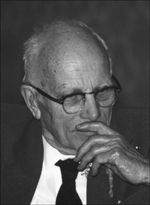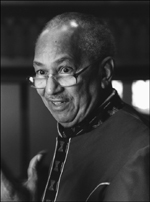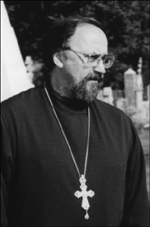 |
| The Reverend John Beardslee at his eightieth birthday party: A historian to whom the long view comes naturally. |
“Things change so rapidly in theological education that projections for even the next eight years are foolish,” said John Beardslee, recently retired professor of church history at New Brunswick Theological Seminary. “The only detailed prediction I made that has been vindicated is that the school would be unrecognizable in a quarter of a century.”
Fair enough. But how then are those responsible for the futures of theological schools to make decisions that push their institutions into good new directions? One part of the answer is to listen to the institution’s elders and sages, those connected with the school whose years of experience, observation, and common sense have established them as keepers of the school’s stories and, eventually, its sources of wisdom.
The three people interviewed for this article were chosen because the presidents of their schools did not pause for a moment before identifying them as the keepers of institutional wisdom. Their roles at their schools differ: Beardslee is a faculty member, Bishop Vinton Anderson is Payne Theological Seminary’s board chair, and Father Alexander Golubov is academic dean at St. Tikhon’s Orthodox Theological Seminary. The mix of responsibilities is intentional, but not exhaustive. Sometimes a school’s sage is to be found managing the physical plant or running the infirmary or in the president’s office. A governing board’s challenge is to find its own.
Lively Historian
If Vinton Anderson is correct when he asserts, “Real colorful people are the sages, and it takes time to take on that aura,” John Beardslee comes to the role naturally. His thirty-odd-year tenure at New Brunswick, a Reformed Church in America school in New Jersey, is not unique, but how many professors are the third generation of their families to teach at the same school? (And Beardslee has a model for working long: his grandfather didn’t start teaching at New Brunswick until he was eighty.)
 |
Bishop Vinton Anderson: Shaped by the school he is now shaping.
Photograph by
Charles Stech |
Although now retired, Beardslee continues a part of the school’s daily life, and Norman Kansfield, New Brunswick’s president, is helping to ensure that the pattern continues. “John keeps an office on campus, and we’re moving it right next to the receptionist. And as each new group of students comes in, I have John to do the opening prayer—because of all our faculty, he is most inclusive, not only in terms of language, but also content.” Beverly Sullivant, a student and the school’s receptionist, said, “He takes you by surprise: he shows up for events and you think he’s just this old guy. He knows this, and does the work of overcoming it. And he insists on honesty: when a group of students being interviewed for a denominational video were giving pat answers, he apparently thought we were holding back because of him and quietly said, ‘Oh, that can’t be what you really feel. Perhaps I should leave the room.’ The conversation got livelier.”
Part of Beardslee’s genius is his ability to combine the traditional with the surprising. He wears a suit and a white shirt—but on the lapel is a tiny rainbow ribbon, a ribbon of the sort that can be found in a bowl in the school’s front hall with a prayer of thanksgiving for diversity, including diversity in sexual orientation. His living room is distinctly academic and heavily bookshelved, but a three-foot-tall stuffed penguin stands by the piano (“My daughter rescued it on the beach. It’s stayed here since,” Beardslee explained). He insists that contrary to popular wisdom, the quality of today’s students is very high. He adds, however, “When they can’t write—and many of them can’t—somebody has to tell them so.”
Kansfield describes Beardslee’s presence at meetings as “rather tight-lipped. But when John speaks, the faculty listens. He takes the long view with an ethical perspective.” Beardslee is a historian. The long view comes to him naturally, and his discussion of current church issues is peppered with illustrations from other times and places. He is committed to conversations across disciplines, too, and is dismayed that more of the seminary community isn’t present for lectures on ethics at the legal and dental schools of nearby Rutgers University, for example. He encourages board members to attend classes at the seminary, and he is sweetly untroubled when he says, “And if it’s a course in Old Testament criticism, they’re in for a shock.”
Beardslee has seen that conversation marked by careful listening can save untold troubles. He cites as an example an incident in the 1960s. “It was a time of panic in the school,” he said. “There was a sense that, ‘if we don’t do something to show we’re alive, we’re dead.” Two old campus buildings were torn down and a new one was erected: the centerpiece was to be a new chapel. “The architect knew that he didn’t want anything like the Rutgers chapel. That was fair enough, but nobody sat down with him and told him what we wanted. In fact, we didn’t talk much ourselves about what we wanted. We should have listened to our librarian at the time, who said, ‘We should discuss with the architect about what a seminary chapel is for.’ Nobody did. Nobody else—trustees, faculty, administration—caught on until it was too late.”
On the outside New Brunswick’s chapel bears a disturbing resemblance to an overturned Dixie cup. Its interior, patterned after an eighteenth century Dutch parish church, does not mesh well with the role of a seminary chapel. (The original wall-mounted pulpit has since come down.) The acoustics are quirky. “For a while some students used the space for some interesting theater,” said Beardslee with a shrug.
Sage Opinions
On the long view:
Beardslee: In the course of church history, most people weren't aware of what was going on.
Anderson: My sense of responsibility for the school is a remembrance of good things people there have done to aid me. That becomes the voice that reminds me that others need love, care, and support. |
Beardslee can hang onto the thread of a conversation like few others. After two afternoons of far-ranging conversation, he wound his way back to his first point. “Now, about the future of the seminary. In a world that was much more static, the church conformed to the world, and was more static than it ought to have been. Now the church is going to be different. Therefore the seminary had better be.”
Trustee Visionary
Residency at the school is not a required characteristic of wisdom keepers. When asked if students know who board chair Bishop Vinton Anderson is, Obery Hendrix, the new president of Payne Theological Seminary, was taken aback. “Of course they know him, and not just because he’s bishop to some of them. He’s a presence here.”
Hendrix says he was perfectly content teaching New Testament at the Drew University Theological School. But then Vinton Anderson came calling, summoned his considerable powers of persuasion to sell the professor on the Anderson vision for Payne, and convinced Hendrix that he could help move the school forward.
When he was asked what he has learned from Anderson, Hendrix’s first, unconsidered response was, “Nowhere near as much as I need to!”
Which is not to suggest that what he has learned is inconsiderable. “I am learning from him to be an astute administrator, to lead from listening, to hold fast to convictions without alienating others. The tone of this school is set by the largeness of Anderson’s vision.”
Vinton Anderson was shaped by the school he is now shaping. He says that family legend has it that he decided to be a bishop “when I first saw one when I was a little fella.” Nonetheless when he came to the African Methodist Episcopal school in Wilberforce, Ohio, in 1947, he was a candidate for considerable shaping. He had spent five years as a carpenter’s apprentice in the dockyards of his native Bermuda. He came to a school with a marvelously well educated and committed (if small) faculty, but few other resources.
“When I went to the campus, we had one little building with administration, chapel, classrooms, library, and restrooms all downstairs. We slept on the second floor, and we shared not only rooms but beds.” During his tenure as a student a second building was built; students carried the bricks from a boxcar to the building site while the dean’s wife cooked beans and ham hocks to feed them. When asked about pictures of this event, Anderson assumed a bemused look behind his cherry desk. ”We didn’t have cameras,” he explained gently.
Sage Opinions
On doing what one needs to do:
Anderson: At every event of the school board meetings, founder's day, even commencement, there's an opportunity to pledge and to give. I do not apologize for this; it's the way Payne survives with dignity.
Golubov: Sometimes the faculty has to be parent to students. Sometimes you have to be daddy and tell them what's what. |
Anderson profoundly appreciates what the school gave him, educationally and in terms of community. “My first Thanksgiving, I had nowhere to go and I didn’t know what the holiday was about,” he recalled. “A faculty member brought me into his home. You don’t forget things like that.” Anderson’s memory is astounding. “There were only six women on campus while I was there,” he said. And then he went on to name them. He can run through a list of the school’s presidents that he has known, volunteering details about the highlights of their careers.
Anderson became a member of Payne’s board while still a pastor, and has been on the board now “for at least thirty-five years.” When Anderson was elevated to bishop in 1972, he began to challenge his episcopal district to increase its giving to Payne and to send more students. He has followed the same pattern in all four of his episcopal assignments. (He is currently bishop of the AME Church’s second district, which covers Maryland, Virginia, North Carolina, and the District of Columbia.)
He has been board chair for ten years, during which time the school celebrated its 150th anniversary. “The crowning event of our sesquicentennial,” he said, “was our accreditation by the Association of Theological Schools.” He has more plans for the school. He is celebrating the end of his eight-year tenure as a president of the World Council of Churches with the institution of a scholarship that will send Payne students and others to the Council’s Graduate School of the Ecumenical Institute at Bossey, Switzerland. And when he speaks of old Mitchell Hall, which was the seminary when he was there, he notes that it is now boarded up, but that funds are being raised to rehabilitate it.
The Reverend Louis-Charles Harvey, a previous president of Payne who is now pastor of historic Metropolitan A.M.E. Church in Washington, describes Anderson’s genius as “the ability to conceptualize changes and bring them to fruition.” Sometimes that has meant getting reluctant congregations to give money to a school in the midst of hard times. “But he never asks people to do what he wouldn’t,” said Harvey, “and he leads by example: ‘I believe in this school, and you should, too.’ He has an amazing pastoral ability to recognize gifts and skills, to give people the authority to use them, and to support them without meddling.”
Active Fulcrum
 |
The Reverend Alexander Golubov: possessor of an “almost gyroscopic” sense of balance in a school with approximately equal numbers of lifelong Orthodox, converts, and international students..
Photograph by
Martin Paluch |
The Reverend Alexander Golubov, academic dean of St. Tikhon’s Orthodox Theological Seminary in South Canaan, Pennsylvania, is twenty years younger than Anderson and more than thirty years younger than Beardslee. He has spent far less time than they associated with his school. He can, to be sure, tell the stories that define the school. Listen to him quote Bishop Jonah discussing the seminary chapel: “Your most important classroom is right here. Here you will learn what no classroom will be able to teach you. Here you will learn the beauty of Orthodox worship. Here you will be schooled in the wisdom of the Fathers.” It is not at first apparent that Golubov didn’t hear those words firsthand. But Jonah’s tenure as St. Tikhon’s rector was in the early 1950s. Golubov didn’t arrive until the spring of 1984. Shortly after he was assigned to a parish in Scranton, he came to visit with a trustee he had met earlier. In the fall of 1984 he began teaching at St. Tikhon’s—and continued to do so intermittently until he was called to be academic dean.
Golubov is not St. Tikhon’s only storyteller. Sergei Arhipov, the school’s librarian and registrar, tells the same Bishop Jonah story without any prompting. Arhipov, who is not a priest and who came to the school from a career in military intelligence, remembers cutting classes at his suburban Philadelphia high school to drive deep into the Poconos to St. Tikhon’s, where he would spend the day “scraping up wax in the chapel, whatever ... just being here.” His devotion to the school differs in degree but not in substance from that of many members of the Orthodox Church in America. Every spring they come by the busloads to the distinctly rural school for the annual pilgrimage. They come to worship, to hear teaching from their spiritual leaders, but also to help support the monastery that shares grounds with the seminary, and to visit their dead at the cemetery. “Everybody ends up here eventually.” Golubov smiled. “Everybody” includes Alexander Schmemann, the leading American Orthodox scholar of the twentieth century and longtime dean of St. Vladimir’s Theological Seminary, one of the O.C.A.’s other schools. Schmemann never taught at St. Tikhon’s, but he’s buried there.
St. Tikhon’s does not lack for keepers of the institutional memory, so wisdom here must have another element. In Golubov’s case, it seems to be an almost gyroscopic sense of balance in a school with approximately equal numbers of lifelong Orthodox, converts, and international students. Golubov was born in Germany to a family that had been chased around Europe by the political vagaries of the early twentieth century; he grew up in New Jersey. His first theological training was in what was then Leningrad. His career as a priest and theologian has been almost equally divided between the parish and academia, and he has rarely been without a foot in each. The mix, he said, has “sustained me spiritually and fed me intellectually.” He glories in the local expression of the church. Of his first parish, St. George’s in Queens, New York, he says: “When everybody showed up, there were fourteen of us. It was magnificent.” At the same time, he shows his commitment to the larger church by working hard to maintain connections across denominational lines with groups like the Association of Theological Schools, which he says has taught him that “apart from theological content of doctrine, theological schools share the same set of problems. And it is the common vocation of theological faculties both to serve and educate the church.”
Sage Opinions
On faculty/board relationships:
Golubov: It's like we tell people who are getting married, most problems will be resolved with the time you spend talking to one another. And it's impossible to do too much listening.
Beardslee: Our faculty: If the board makes a decision we like, we're for the board. If they don't, we're against them. |
Golubov’s connection to the past becomes evident on a campus tour. After showing the school and the monastery, he strode over the crest of a hill, cassock flapping in the wind, and announced, “And here’s our third community.” He gestured toward the cemetery. His commitment to the future is equally strong. It led him to spend months “living and breathing” a report on a proposal to lengthen the school’s course of study from three years to four.
The dean, in Golubov’s view, is the “fulcrum” of the seminary (Golubov speaking less metaphorically and more bluntly also said of deaning that “mostly the job is paperwork that can keep you from real life—but somebody has to do it”). A fulcrum—the point on which a lever rests—is not a weight, though, and has no power of its own. Golubov has learned, he said, that “true power is found in powerlessness: not in prescribing answers to those responsible for decisions, but letting them stew until they come up with their own.” The central question for the seminary, said Golubov, is how to prepare priests for modern America—and prepare priests returning to the motherland. The center of the answer is his assertion that “the nittygritties of what Christ taught are still applicable to our country—and Ukraine, and France, and Russia, and even India and Africa. We have to be challenged by the eternal and by the temporal.”
Finding Your Wisdom
A few hours spent with each of these three provides more instruction than this magazine has room for, but that’s not the point. Every school has sages or potential sages. Boards and administrators owe it to themselves and their school to seek out and nurture their wisdom. Celebrate them. Make sure the stories that have shaped your school till now continue to provide a foundation for a future as yet unseen.